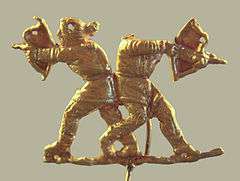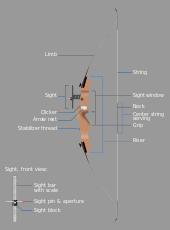Recurve bow
A recurve bow is a bow with limbs that curve away from the archer when unstrung. A recurve bow stores more energy and delivers energy more efficiently than the equivalent straight-limbed bow, giving a greater amount of energy and speed to the arrow. A recurve will permit a shorter bow than the simple straight limb bow for a given arrow energy and this form was often preferred by archers in environments where long weapons could be cumbersome, such as in brush and forest terrain, or while on horseback.
Recurved limbs also put greater stress on the materials used to make the bow, and they may make more noise with the shot. Extreme recurves make the bow unstable when being strung. An unstrung recurve bow can have a confusing shape and many Native American weapons, when separated from their original owners and cultures, were incorrectly strung backwards and destroyed when attempts were made to shoot them.[1][2]
Historical and current use

Perhaps the most ancient written record of the use of recurved bows is found Psalm 78:57 ("They were turned aside like a deceitful bow" KJV), which is dated by most scholars to the eighth century BC.[3] Adam Clarke points out that "If a person, who is unskillful or weak, attempt to recurve and string one of these bows, if he take not great heed, it will spring back, and regain its quiescent position; and, perhaps, break his arm. And sometimes I have known it, when bent, to start aside, - regain its quiescent position, to my no small danger...this is precisely the kind of bow mentioned by Homer, Odyss. xxi, which none of Penelope's suitors could bend, called καμπυλα τοξα [kampula toxa] in the state of rest; but τοξον παλιντονον [toxon palintonon], the recurved bow when prepared for use." [4]
Recurve bows made out of composite materials were used by, among other groups, the Persians, Parthians, Sarmatians, Scythians, Alans, Dacians, Cumans, Hyksos, Magyars, Huns, Bulgars, Greeks, Turks, Mongols, Koreans and Chinese. The recurve bow spread to Egypt and much of Asia in the second millennium BC. The standard weapon of Roman imperial archers was a composite recurve, and the stiffening laths (also called siyah in Arabic/Asian bows[5] and szarv (horns) in Hungarian bows) used to form the actual recurved ends have been found on Roman sites throughout the Empire, as far north as Bar Hill on the Antonine Wall in Scotland.[6] During the Middle Ages composite recurve bows were used in the drier European countries; the all-wooden straight longbow was the normal form in wetter areas. Recurve bows depicted in the British Isles (see illustrations in "The Great War Bow")[7] may have been composite weapons, or wooden bows with ends recurved by heat and force, or simply artistic licence. Many North American bows were recurved, especially West Coast bows. Recurve bows went out of widespread use, for war, with the availability of effective firearms. Self bows, composite bows, and laminated bows using the recurve form are still made and used by bowyers, amateurs, and professional archers.
Modern use
The unqualified phrase "recurve bow" or just "a recurve" in modern archery circles usually refers to a typical modern recurve bow, as used by archers in the Olympics and many other competitive events. It employs advanced technologies and materials. The limbs are usually made from multiple layers of fiberglass, carbon and/or wood on a core of carbon foam or wood. The riser (the centre section of the bow) is generally separate and is constructed from wood, carbon, aluminium alloy or magnesium alloy. The term 'riser' is used because, in a one-piece bow, the centre section rises from the limbs in a taper to spread the stress. Several manufacturers produce risers made of carbon fibre (with metal fittings) or aluminium with carbon fibre. Risers for beginners are usually made of wood or plastic. The synthetic materials allow economic, predictable manufacture for consistent performance. The greater mass of a modern bow is in itself an aid to stability, and therefore to accuracy. However, accuracy is also related to a bow's draw weight, as well as how well an archer handles it. It is therefore imperative for an archer, particularly a beginner, never to overestimate their capabilities, and to choose a draw weight that is appropriate for their body build and level of experience.[8]
The modern recurve is the only form of bow permitted in the Olympics (though the compound bow is permitted in some categories at the Paralympic Games) and is the most widely used by European and Asian sporting archers.
There is a movement to have future Olympic Games include the Compound bow into competition, due to its framework technology being more available and widespread, making competitive stat tracking/testing easier.[9]
The modern Olympic-style recurve is a development of the American flatbow, with rectangular-section limbs that taper towards the limb tips. Most recurves today are "take-down" bows: that is, the limbs can be detached from the riser for ease of transportation and storage, and for interchangeability. Older recurves and some modern hunting recurves are one-piece bows. Hunters often prefer one-piece bows over take-down bows because the limb pockets on take-down bows can be a source of noise while drawing.
Terminology

- Arrow rest
- Where the arrow rests during draw. These may be simple fixed rests or may be spring-loaded or magnetic flip rests.
- Back
- The face of the bow on the opposite side to the string
- Belly
- The face of the bow on the same side as the string
- Bow sight
- An aiming aid attached to the riser
- Brace height
- The distance between the deepest part of the grip and the string; fistmele is the traditional term, referring to the equivalent length of a closed fist with the thumb extended, indicating the proper traditional distance used between the deepest part of the grip and the string.
- Grip
- The part of the bow held by the bow hand
- Limbs
- The upper and lower working parts of the bow, which come in a variety of different poundages
- Nocking point
- The place on the bowstring where the nock (end) of an arrow is fitted
- Riser
- The rigid centre section of a bow to which the limbs are attached
- String
- The cord that attaches to both limb tips and transforms stored energy from the limbs into kinetic energy in the arrow
- Sling
- A strap or cord attached to the bow handle, wrist or fingers to prevent the bow from falling from the hand
- Tab or thumb ring
- A protection for the digits that draw the string. Also provides better release performance. Usually made of leather.
- Tiller
- The difference between the limb-string distances measured where the limbs are attached to the riser. Usually the upper distance is slightly more than the bottom one, resulting in a positive tiller. Reflects the power-balance between both limbs.
Other equipment
Archers often have many other pieces of equipment attached to their recurve bows, such as:
- Clicker
- a blade or wire device fitted to the riser, positioned to drop off the arrow when the archer has reached optimum draw length. Used correctly, this ensures the same cast-force each time. Many archers train themselves to shoot automatically when the clicker 'clicks' off the arrow.
- Kisser
- a button or nodule attached to the bowstring. The archer touches the kisser to the same spot on the face each time (usually the lips, hence the name) to give a consistent vertical reference.
- Plunger button
- a fine-tuning device consisting of a spring-cushioned tip inside a housing. The plunger button screws through the riser so that the tip emerges above the rest. The side of the arrow is in contact with the tip when the arrow is on the rest. The spring is tuned so that it allows a certain amount of movement of the arrow towards the riser on release, bringing the arrow to the ideal "centre shot" location. The plunger button is used to compensate for the arrow's flex, since the arrow flexes as the string pushes onto it with a very high acceleration. The device is also known as a cushion plunger, pressure button, or Berger button.
- Stabilizers
- weight-bearing rods attached to a recurve bow to balance the bow to the archer's liking, and to dampen the effect of torque and dissipate vibration.
See also
- Crossbow
- Mongol bow
- Turkish bow
- Flatbow
- Bow draw
References
- American Indian Archery. Reginald Laubin, Gladys Laubin. University of Oklahoma Press 1980. ISBN 0-8061-1467-3 ISBN 978-0-8061-1467-5
- Adam (2017-10-21). "The 10 Best Recurve Bow 2019 [UPDATED] Which is the best?". The Archery Guide. Retrieved 2019-12-05.
- W. Stewart McCullough, The Interpreter's Bible, Volume IV, 1955, Parthenon Press, Nashville, 51-12276, p. 415,
- Adam Clarke, Commentary on the Bible, 1831, Emory and Waugh, NY, volume III p. 244
- R.P.Elmer 'Target Archery'
- Coulston JC. 'Roman Archery Equipment', in M.C. Bishop (ed.), The Production and Distribution of Roman Military Equipment. Proceedings of the Second Roman Military Equipment Seminar, BAR International Series 275, Oxford, 1985, 220-366.
- The Great War Bow. Hardy R, Strickland M. Sutton Publishing 2005. ISBN 0-7509-3167-1 ISBN 978-0-7509-3167-0
- Recurve bow draw weight chart
- Cirino, Erica. "Compound Archery Shoots for Olympic Inclusion". Scientific American. Retrieved 2020-03-12.
Further reading
- The Traditional Bowyers Bible Volume 1. The Lyons Press, 1992. ISBN 1-58574-085-3
- The Traditional Bowyers Bible Volume 2. The Lyons Press, 1992. ISBN 1-58574-086-1
- The Traditional Bowyers Bible Volume 3. The Lyons Press, 1994. ISBN 1-58574-087-X
- The Traditional Bowyers Bible Volume 4. The Lyons Press, 2008. ISBN 978-0-9645741-6-8
